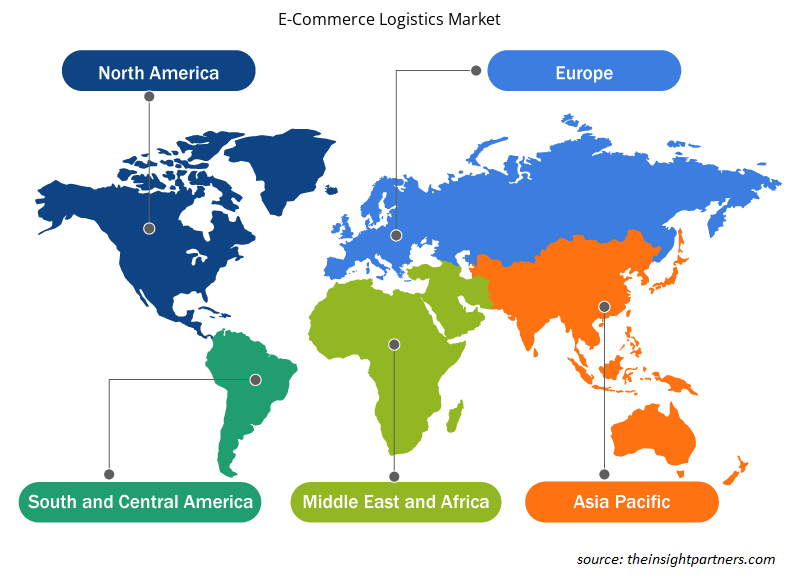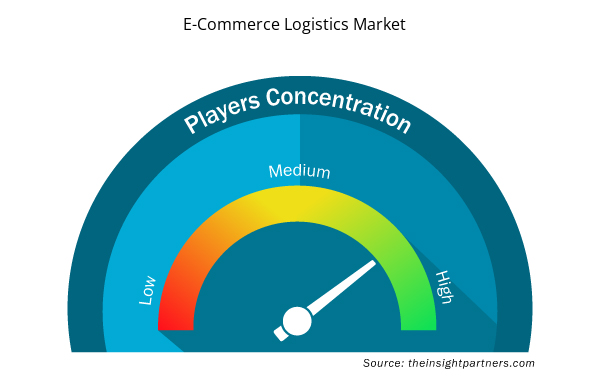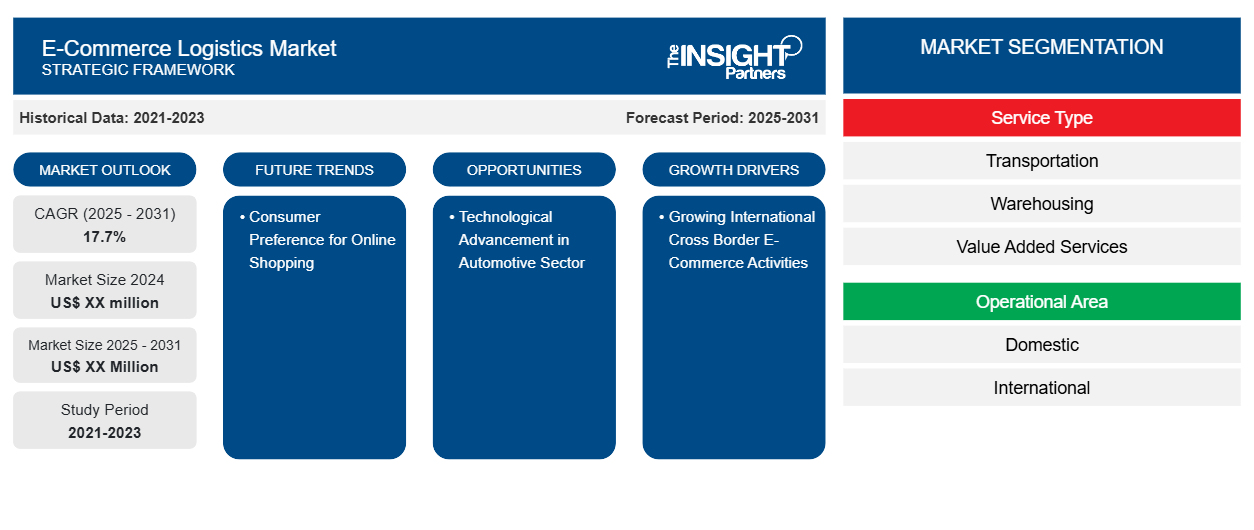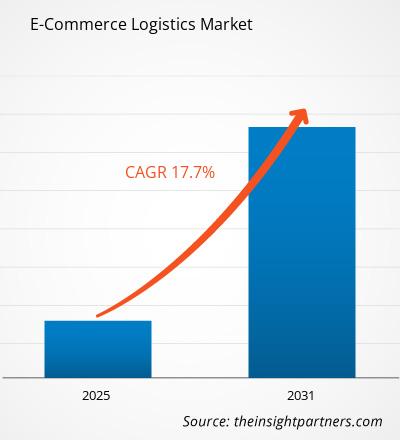Si prevede che il mercato della logistica dell'e-commerce registrerà un CAGR del 17,7% nel periodo 2023-2031. L'evoluzione delle tecnologie avanzate nel settore della logistica e la crescente preferenza dei consumatori per lo shopping online rimarranno probabilmente una tendenza chiave nel mercato.
Analisi del mercato della logistica dell'e-commerce
- Si prevede che il mercato globale della logistica dell'e-commerce registrerà una crescita elevata durante il periodo di previsione.
- Si prevede che l'incremento delle attività commerciali transfrontaliere e la crescente preferenza dei consumatori per gli acquisti online stimoleranno la domanda del mercato della logistica dell'e-commerce a livello globale.
Panoramica del mercato della logistica dell'e-commerce
- Il mercato della logistica dell'e-commerce comprende servizi quali imballaggio , servizi a valore aggiunto, trasporto e magazzinaggio.
- Lo sviluppo delle tecnologie digitali ha portato a un aumento della domanda di logistica per l'e-commerce in diverse applicazioni.
- Le principali forze alla base della crescita del business online sono l'espansione dell'e-commerce transfrontaliero e il crescente numero di utenti Internet, soprattutto nei paesi in via di sviluppo.
Personalizza questo report in base alle tue esigenze
Riceverai la personalizzazione gratuita di qualsiasi report, comprese parti di questo report, o analisi a livello nazionale, pacchetto dati Excel, oltre a usufruire di grandi offerte e sconti per start-up e università
- Scopri le principali tendenze di mercato in questo rapporto.Questo campione GRATUITO includerà analisi di dati che spaziano dalle tendenze di mercato alle stime e alle previsioni.
Driver e opportunità del mercato della logistica dell'e-commerce
Crescita delle attività di commercio elettronico transfrontaliero internazionale per favorire il mercato
- Si prevede che la crescente proliferazione di attività di commercio elettronico transfrontaliero internazionale guiderà la crescita del mercato della logistica dell'e-commerce.
- L'urbanizzazione, l'aumento del reddito disponibile nei mercati in via di sviluppo, i progressi tecnologici e le prestazioni stanno guidando lo sviluppo del mercato della logistica dell'e-commerce.
Preferenza dei consumatori per lo shopping online
- La crescente preferenza dei consumatori per gli acquisti online sta determinando una crescita della domanda nel mercato della logistica dell'e-commerce a livello globale.
- I clienti stanno optando per opzioni di acquisto comodamente da casa e, dopo il Covid, stanno optando per opzioni di acquisto online poiché hanno più opzioni online rispetto ai negozi fisici, il che sta anche stimolando il mercato della logistica dell'e-commerce a livello globale.
Analisi della segmentazione del rapporto di mercato della logistica dell'e-commerce
I segmenti chiave che hanno contribuito alla derivazione dell'analisi del mercato della logistica dell'e-commerce sono il tipo di servizio, l'area operativa, la categoria e l'utente finale.
- In base al tipo di servizio, il mercato della logistica dell'e-commerce si divide in trasporto e magazzinaggio.
- In base all'area operativa, il mercato della logistica dell'e-commerce si divide in internazionale e nazionale.
- In base alla categoria, il mercato della logistica dell'e-commerce è suddiviso in abbigliamento e stile di vita, automotive, libri e periodici, beni di largo consumo ed elettronica di consumo , assistenza sanitaria e altri.FMCG and consumer
- In base agli utenti finali, il mercato della logistica dell'e-commerce si divide in B2B e B2C.
Analisi della quota di mercato della logistica dell'e-commerce per area geografica
- Il rapporto sul mercato della logistica dell'e-commerce comprende un'analisi dettagliata di cinque principali regioni geografiche, che include le dimensioni attuali e storiche del mercato e le previsioni per il periodo 2021-2031, coprendo Nord America, Europa, Asia-Pacifico (APAC), Medio Oriente e Africa (MEA) e Sud e Centro America.APAC), Middle East and Africa (MEA), and South & Central America.
- Ogni regione è ulteriormente suddivisa in sottosegmenti nei rispettivi paesi. Questo rapporto fornisce analisi e previsioni di oltre 18 paesi, che coprono le dinamiche del mercato della logistica dell'e-commerce, come driver, tendenze e opportunità che stanno influenzando i mercati a livello regionale.
- Il rapporto comprende inoltre l'analisi PEST, che prevede lo studio dei principali fattori che influenzano il mercato della logistica dell'e-commerce in queste regioni.
Approfondimenti regionali sul mercato della logistica dell'e-commerce
Le tendenze regionali e i fattori che influenzano il mercato della logistica dell'e-commerce durante il periodo di previsione sono stati ampiamente spiegati dagli analisti di Insight Partners. Questa sezione discute anche i segmenti e la geografia del mercato della logistica dell'e-commerce in Nord America, Europa, Asia Pacifico, Medio Oriente e Africa e America centrale e meridionale.

- Ottieni i dati specifici regionali per il mercato della logistica dell'e-commerce
Ambito del rapporto sul mercato della logistica dell'e-commerce
| Attributo del report | Dettagli |
|---|---|
| Dimensioni del mercato nel 2023 | XX milioni di dollari USA |
| Dimensioni del mercato entro il 2031 | XX milioni di dollari USA |
| CAGR globale (2024 - 2031) | 17,7% |
| Dati storici | 2021-2022 |
| Periodo di previsione | 2024-2031 |
| Segmenti coperti | Per tipo di servizio
|
| Regioni e Paesi coperti | America del Nord
|
| Leader di mercato e profili aziendali chiave |
|
Densità degli attori del mercato: comprendere il suo impatto sulle dinamiche aziendali
Il mercato della logistica dell'e-commerce sta crescendo rapidamente, spinto dalla crescente domanda degli utenti finali dovuta a fattori quali l'evoluzione delle preferenze dei consumatori, i progressi tecnologici e una maggiore consapevolezza dei vantaggi del prodotto. Con l'aumento della domanda, le aziende stanno ampliando le loro offerte, innovando per soddisfare le esigenze dei consumatori e capitalizzando sulle tendenze emergenti, il che alimenta ulteriormente la crescita del mercato.
La densità degli operatori di mercato si riferisce alla distribuzione di aziende o società che operano in un particolare mercato o settore. Indica quanti concorrenti (operatori di mercato) sono presenti in un dato spazio di mercato in relazione alle sue dimensioni o al valore di mercato totale.
Le principali aziende che operano nel mercato della logistica dell'e-commerce sono:
- Azienda Logistica Clipper Plc.
- Società per azioni Ceva LLC
- Aramex Internazionale
- Amazzone
- Servizio pacchi unito, Inc.
- Società FedEx
Disclaimer : le aziende elencate sopra non sono classificate secondo un ordine particolare.

- Ottieni una panoramica dei principali attori del mercato della logistica dell'e-commerce
Notizie e sviluppi recenti sul mercato della logistica dell'e-commerce
Il mercato della logistica dell'e-commerce viene valutato raccogliendo dati qualitativi e quantitativi dopo la ricerca primaria e secondaria, che include importanti pubblicazioni aziendali, dati associativi e database. Di seguito sono elencati alcuni degli sviluppi nel mercato della logistica dell'e-commerce:
- DHL Global Forwarding ha collaborato con Schneider Electric per progettare e lanciare un modello di spedizione multimodale, il primo nel settore, che utilizza carburanti sostenibili per l'aviazione (SAF) per contribuire a migliorare l'agilità e ridurre l'impatto ambientale della sua supply chain. Insieme a Schneider Electric, DHL Global Forwarding ha implementato due ponti di spedizione multimodali, tra Singapore e Nord America e tra India e Nord America, per ridurre le emissioni di carbonio di Scope 3 del trasporto aereo. In totale, Schneider Electric prevede di progettare ed eseguire otto ponti multimodali globali con i suoi partner logistici che possono essere implementati su richiesta. (Fonte: DHL Global Forwarding, comunicato stampa, febbraio 2024)
- DHL Global Forwarding, il principale fornitore internazionale di servizi di trasporto merci aereo, marittimo e su strada, ha inaugurato un nuovo hub di trasbordo e una sede centrale a Johannesburg, in Sudafrica. (Fonte: DHL Global Forwarding, comunicato stampa, settembre 2022)
Copertura e risultati del rapporto sul mercato della logistica dell'e-commerce
Il rapporto “Dimensioni e previsioni del mercato della logistica dell’e-commerce (2021-2031)” fornisce un’analisi dettagliata del mercato che copre le seguenti aree:
- Dimensioni e previsioni del mercato della logistica dell'e-commerce a livello globale, regionale e nazionale per tutti i segmenti di mercato chiave coperti dall'ambito
- Tendenze del mercato della logistica dell'e-commerce e dinamiche di mercato come fattori trainanti, limitazioni e opportunità chiave
- Analisi dettagliata delle cinque forze PEST/Porter e SWOT
- Analisi del mercato della logistica dell'e-commerce che copre le principali tendenze del mercato, il quadro globale e regionale, i principali attori, le normative e i recenti sviluppi del mercato
- Analisi del panorama industriale e della concorrenza che copre la concentrazione del mercato, l'analisi della mappa di calore, i principali attori e gli sviluppi recenti nel mercato della logistica dell'e-commerce
- Profili aziendali dettagliati
- Analisi storica (2 anni), anno base, previsione (7 anni) con CAGR
- Analisi PEST e SWOT
- Valore/volume delle dimensioni del mercato - Globale, regionale, nazionale
- Industria e panorama competitivo
- Set di dati Excel


- Trade Promotion Management Software Market
- Ceramic Injection Molding Market
- Vision Care Market
- Quantitative Structure-Activity Relationship (QSAR) Market
- Ceiling Fans Market
- Extracellular Matrix Market
- MEMS Foundry Market
- Blood Collection Devices Market
- Single Pair Ethernet Market
- Grant Management Software Market

Report Coverage
Revenue forecast, Company Analysis, Industry landscape, Growth factors, and Trends

Segment Covered
This text is related
to segments covered.

Regional Scope
North America, Europe, Asia Pacific, Middle East & Africa, South & Central America

Country Scope
This text is related
to country scope.
Domande frequenti
Some of the customization options available based on the request are an additional 3–5 company profiles and country-specific analysis of 3–5 countries of your choice. Customizations are to be requested/discussed before making final order confirmation, as our team would review the same and check the feasibility.
The major factors driving the E-Commerce Logistics Market are: Advent of Advanced Technology such as Automation, Blockchain, and other
The E-Commerce Logistics Market is estimated to witness a CAGR of 17.4% from 2023 to 2031
Changing customer preference is the key future trend of the E-Commerce Logistics Market
The leading players operating in the E-Commerce Logistics Market include FedEx Corporation, DHL International GmbH, Aramex International, XPO Logistics Plc.,United Parcel Service, Inc., Gati Limited, Kenco Group, Inc., Clipper Logistics Plc., Agility Public Warehousing Company K.S.C.P. and CEVA Logistics.
The report can be delivered in PDF/PPT format; we can also share excel dataset based on the request.
Trends and growth analysis reports related to Automotive and Transportation : READ MORE..
The List of Companies
1. Amazon.com, Inc.
2. C.H. Robinson Worldwide, Inc.
3. CEVA Logistics
4. Clipper Logistics Plc.
5. DHL International GmbH
6. FedEx Corporation
7. Kerry Logistics Network Limited.
8. Nippon Express Co., Ltd.
9. SF Express Co., Ltd.
10. United Parcel Service, Inc.
The Insight Partners performs research in 4 major stages: Data Collection & Secondary Research, Primary Research, Data Analysis and Data Triangulation & Final Review.
- Data Collection and Secondary Research:
As a market research and consulting firm operating from a decade, we have published and advised several client across the globe. First step for any study will start with an assessment of currently available data and insights from existing reports. Further, historical and current market information is collected from Investor Presentations, Annual Reports, SEC Filings, etc., and other information related to company’s performance and market positioning are gathered from Paid Databases (Factiva, Hoovers, and Reuters) and various other publications available in public domain.
Several associations trade associates, technical forums, institutes, societies and organization are accessed to gain technical as well as market related insights through their publications such as research papers, blogs and press releases related to the studies are referred to get cues about the market. Further, white papers, journals, magazines, and other news articles published in last 3 years are scrutinized and analyzed to understand the current market trends.
- Primary Research:
The primarily interview analysis comprise of data obtained from industry participants interview and answers to survey questions gathered by in-house primary team.
For primary research, interviews are conducted with industry experts/CEOs/Marketing Managers/VPs/Subject Matter Experts from both demand and supply side to get a 360-degree view of the market. The primary team conducts several interviews based on the complexity of the markets to understand the various market trends and dynamics which makes research more credible and precise.
A typical research interview fulfils the following functions:
- Provides first-hand information on the market size, market trends, growth trends, competitive landscape, and outlook
- Validates and strengthens in-house secondary research findings
- Develops the analysis team’s expertise and market understanding
Primary research involves email interactions and telephone interviews for each market, category, segment, and sub-segment across geographies. The participants who typically take part in such a process include, but are not limited to:
- Industry participants: VPs, business development managers, market intelligence managers and national sales managers
- Outside experts: Valuation experts, research analysts and key opinion leaders specializing in the electronics and semiconductor industry.
Below is the breakup of our primary respondents by company, designation, and region:

Once we receive the confirmation from primary research sources or primary respondents, we finalize the base year market estimation and forecast the data as per the macroeconomic and microeconomic factors assessed during data collection.
- Data Analysis:
Once data is validated through both secondary as well as primary respondents, we finalize the market estimations by hypothesis formulation and factor analysis at regional and country level.
- Macro-Economic Factor Analysis:
We analyse macroeconomic indicators such the gross domestic product (GDP), increase in the demand for goods and services across industries, technological advancement, regional economic growth, governmental policies, the influence of COVID-19, PEST analysis, and other aspects. This analysis aids in setting benchmarks for various nations/regions and approximating market splits. Additionally, the general trend of the aforementioned components aid in determining the market's development possibilities.
- Country Level Data:
Various factors that are especially aligned to the country are taken into account to determine the market size for a certain area and country, including the presence of vendors, such as headquarters and offices, the country's GDP, demand patterns, and industry growth. To comprehend the market dynamics for the nation, a number of growth variables, inhibitors, application areas, and current market trends are researched. The aforementioned elements aid in determining the country's overall market's growth potential.
- Company Profile:
The “Table of Contents” is formulated by listing and analyzing more than 25 - 30 companies operating in the market ecosystem across geographies. However, we profile only 10 companies as a standard practice in our syndicate reports. These 10 companies comprise leading, emerging, and regional players. Nonetheless, our analysis is not restricted to the 10 listed companies, we also analyze other companies present in the market to develop a holistic view and understand the prevailing trends. The “Company Profiles” section in the report covers key facts, business description, products & services, financial information, SWOT analysis, and key developments. The financial information presented is extracted from the annual reports and official documents of the publicly listed companies. Upon collecting the information for the sections of respective companies, we verify them via various primary sources and then compile the data in respective company profiles. The company level information helps us in deriving the base number as well as in forecasting the market size.
- Developing Base Number:
Aggregation of sales statistics (2020-2022) and macro-economic factor, and other secondary and primary research insights are utilized to arrive at base number and related market shares for 2022. The data gaps are identified in this step and relevant market data is analyzed, collected from paid primary interviews or databases. On finalizing the base year market size, forecasts are developed on the basis of macro-economic, industry and market growth factors and company level analysis.
- Data Triangulation and Final Review:
The market findings and base year market size calculations are validated from supply as well as demand side. Demand side validations are based on macro-economic factor analysis and benchmarks for respective regions and countries. In case of supply side validations, revenues of major companies are estimated (in case not available) based on industry benchmark, approximate number of employees, product portfolio, and primary interviews revenues are gathered. Further revenue from target product/service segment is assessed to avoid overshooting of market statistics. In case of heavy deviations between supply and demand side values, all thes steps are repeated to achieve synchronization.
We follow an iterative model, wherein we share our research findings with Subject Matter Experts (SME’s) and Key Opinion Leaders (KOLs) until consensus view of the market is not formulated – this model negates any drastic deviation in the opinions of experts. Only validated and universally acceptable research findings are quoted in our reports.
We have important check points that we use to validate our research findings – which we call – data triangulation, where we validate the information, we generate from secondary sources with primary interviews and then we re-validate with our internal data bases and Subject matter experts. This comprehensive model enables us to deliver high quality, reliable data in shortest possible time.


 Ottieni un campione gratuito per questo repot
Ottieni un campione gratuito per questo repot